- Home
- Dairy market outlook
Dairy market outlook
February 2025
Overview
- GB milk production is forecast to increase moderately in 2025, in the region of 1.1%, due to higher prices, less severely wet weather and easing margins
- Agricultural input costs have settled, compared to the severe inflationary period of 2021/22. Although this means that cost bases have increased in the long term, they have remained relatively stable in the short term and have seen some easing in the past 12 months driven by energy and feed costs
- Global dairy demand is likely to remain challenged by low economic growth; however, there are signs of a nascent resurgence in Chinese demand. Supplies are growing in buoyancy – forecast to be up 0.6%
- Domestic demand is steady, maintaining the longer-term trend of a shift away from liquid consumption towards added-value products like cheese and yogurt. Inflation in fats commodity prices is pressuring consumer demand
- Farmgate prices will stabilise in the first half of 2025 but could see some challenges later in the year if commodity values have passed their peak

Supply
Domestic milk production
GB milk production for the 2024/25 season is forecast to reach 12.43 bn litres, 0.9% more than the previous milk year, according to our December forecast update.
The 2024/25 milk year has been divided into two halves, with the first half lagging behind last year’s production; this was driven by wet weather conditions during the spring season and the preceding autumn and winter months and lower prices. This led to lower yields in the first half, with lower levels of forage availability keeping production behind last year. However, the situation turned in September. Higher milk prices and improving margins − along with good grass growth (varied in regions) and much dryer weather that allowed the cows to stay out for longer − brought a resurgence in milk flows.
A combination of both bullish and bearish factors come into play around this forecast. We are now annualising against a year of lower milk deliveries following poor weather. November and December saw good growth, with volumes up by 4.5% and 3.3%, respectively.
Challenges ease
Milk prices remain elevated compared to last year, the average GB price sat at 45.14 pence per litre (ppl) for Oct 24 (excluding bonus and aligned), an increase of 22% year-on-year. If we take the Defra average (that does not exclude aligned contracts), prices have reached an average of 47ppl as of December.
Commodity markets have been very strong, with butter and bulk cream breaking records last autumn. Although prices have eased to some extent, they remain at very high levels. The expectations for the rest of the milk year are that, with a continuation of the firm tone in prices, farmers will be incentivised to produce more. The boom in autumn calvings and steady milk prices support this.
Farmgate prices have peaked: from next April, we expect milk prices to begin to normalise in response to the growth in milk production. Towards the back end of this year, production is likely to be more subdued comparing to the record highs last year.
In general, inflation in key input costs has ended recently. Although costs remain at historically relatively high levels, we have witnessed some deflation in the year. The steadying of key input costs is likely to improve farmers’ confidence and support them in scaling up production. Feed costs in particular have stabilised at much more reasonable levels. The average feed wheat prices were steady at £187.50/tonne in Jan 25, year-on-year.
The milk-to-feed price ratio is looking very favourable towards expansion in production going ahead. Wet weather through the growing season in 2024 affected the silage quality for some, which could present an issue as the winter progresses. However, the upside in milk prices movement will provide room for the farmers to supplement with extra feed.
The extent of this recovery is also dependant on other significant structural and policy changes across the industry. Changes to inheritance tax announced in the recent Budget has dampened farmer confidence and has been damaging to morale. Increased environmental regulations will also have an impact. Access to cheap credit has been curtailed by interest rates sitting much higher than in the preceding decade. Disease outbreaks such as TB and bluetongue (BTV) also offer a potential risk to the forecast. BTV, in particular, is causing impacts on milk production in affected regions such as Germany and the Netherlands. This could impact the UK from spring as midge season gets underway. An outbreak of foot-and-mouth disease in Germany at the time of publication offers further uncertainty.
Disease risks
The following abnormal risks are likely to impact dairy cows throughout 2025, and we are aware of an increased number of cases. However, we have assumed a minimal impact on production at the UK level in 2025, because this is difficult to predict and quantify. If more severe impacts materialise, our production forecast will look optimistic.
Depending on the strain of virus, scale of any outbreak and the timing of a disease incursion, bluetongue (BTV) can lower productivity (including a reduced milk yield), cause sickness, reduce reproductive performance and cause abortions.
Calves may be born small, weak, deformed or blind, and it may result in increased calf mortality. The impact is difficult to predict but could be high for some herds and significant if a large-scale outbreak were to occur.
Other impacts from bluetongue include disruptions due to impact of prolonged animal movement and trade restrictions, administration and additional costs as a result of restrictions. This includes the need for a licence to move animals out of an affected zone.
These can take up to five days to process, as animals can only exit the zone to move directly to slaughter and may require farmers to change their usual routes to market.
Farmers may incur costs from reduced market access, including export markets. In 2024 the disease spread across part of the country but avoided some key dairy production regions. Wintry conditions have slowed down the spread. The expectation is the virus could spread more widely in 2025, and vaccine uptake remains limited.
Foot-and-mouth disease saw a limited outbreak in January 2025. At the time of writing, it has not spread further, but if it was to spread outside of Germany, it could represent a huge risk to British agriculture.
Farmers should monitor closely and continue to notify any potential disease outbreaks as necessary.
As discussed in our economic outlook for the year, there are a number of economic risks to the global economy. Conflict in the Middle East, China/EU tariff wars and the newly formed government in the USA could produce additional trade frictions and dampen demand.
Higher commodity prices will begin to feed through to consumers, which could put a brake on demand in UK retail at the same time as an oversupply of milk comes into play. This has the potential to put a negative spin on milk prices later in the year. The industry needs to ensure it is prepared for such a possible scenario.
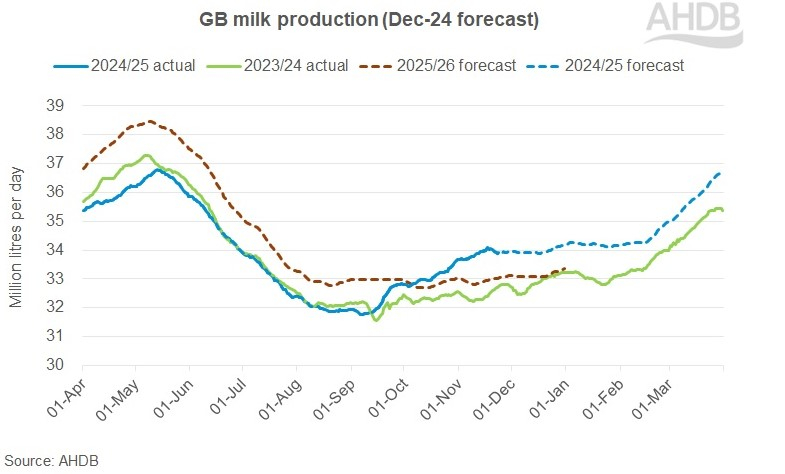
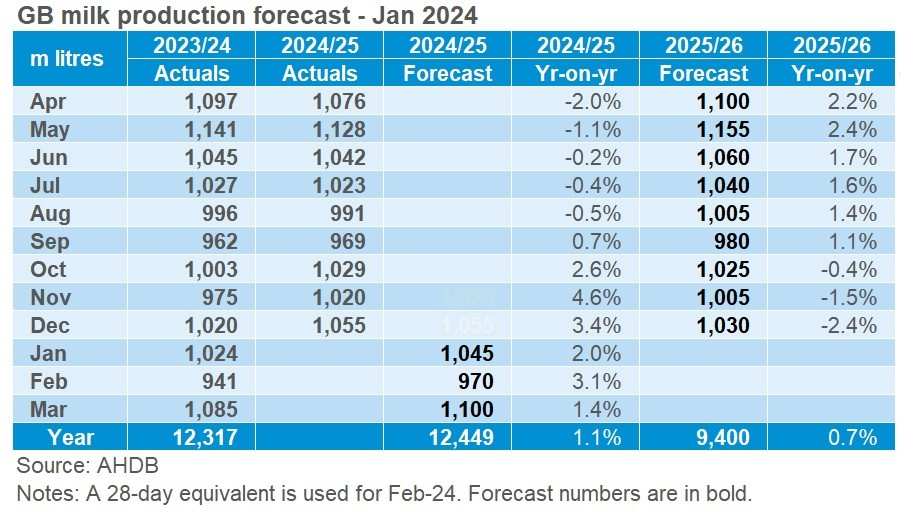
GB production is expected to remain elevated until the autumn. We are annualising against what was a fairly disappointing milk season, given the very wet weather challenges and associated impacts on forage growth. Given this, higher prices and a strong milk-to-feed price ratio should continue to keep milk production buoyant, especially as the new season’s grass comes through. As the year progresses, however, falling milk prices could put a brake on production and some of those structural issues around farmer confidence could come back into play.
The GB milking herd totalled 1.64 million head as of October 2024, the lowest October number recorded, and a 0.9% decrease compared to the same month the previous year. The GB herd total came to 2.55 million head, a year-on-year decline of 1.5%. A fall was seen across all age groups, with the exception of the 2–4-year age bracket. The decline in total cattle numbers confirms that increases in milk supplies have been driven by yield growth.
Culling of older cows helped to maintain the average age of a cow in the GB milking herd at 4.55 years.
Global milk production
According to the latest delivery data for the key milk-producing regions (at time of publication), global production has been returning to growth for the past three consecutive periods. Total production across the key producing regions in the year to date (Jan–Oct 24) was 0.1% lower compared to the previous year due to decline in the first two quarters. Growth in production has been primarily driven by the EU, New Zealand and USA.
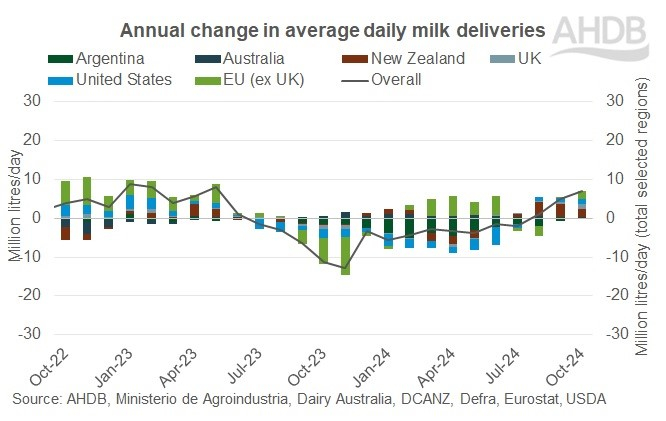
Early forecasts for 2025 suggest a more optimistic pattern and a modest global growth of 0.62%. All key exporting regions expect to see some growth in 2025 due to better margins and feed costs. Australia is the exception which will be highly dependent on rainfall. If the year is wetter, then some growth is to be expected; if the year is dryer, we could see decline. Most of the growth elsewhere in the world is likely to be seen in the first half of 2024 considering the flush period in the northern hemisphere. The USA is likely to play the biggest role generating growth in 2025, but New Zealand is also optimistic.
.jpg)
Product availability
A marginal decline in milk deliveries was reported in EU during the third quarter of 2024 compared to the previous year. Available supplies were trending lower − driven by lower production and mostly lower imports. Slower growth in milk solids added to that reduction. Exports of milk powders plunged during the period, while that of butter and cheese increased marginally. Exports declined to Middle East and certain South East Asian countries. According to the latest data, available supplies declined across the board in the EU-27.
The situation in the UK was little different. Milk powders continued to be in excess for another consecutive quarter, following lower exports, while butter supplies continued to trend down amid limited production. Available supplies of cheese remained at par in the third quarter 2024 compared to the same period in the previous year. Exports and imports of cheese remained in growth, fuelled by domestic and overseas demand.
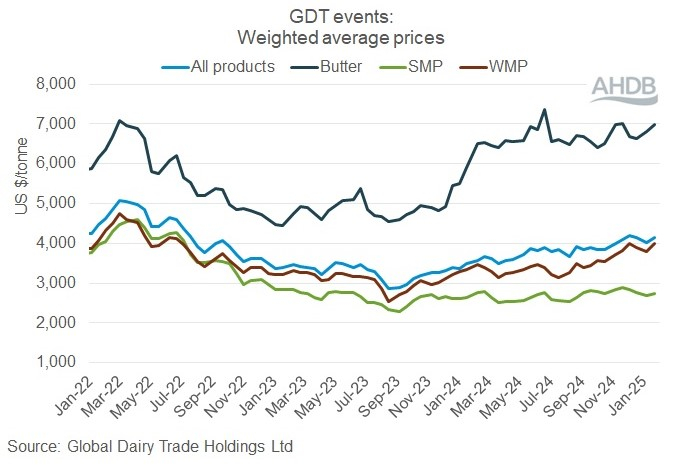
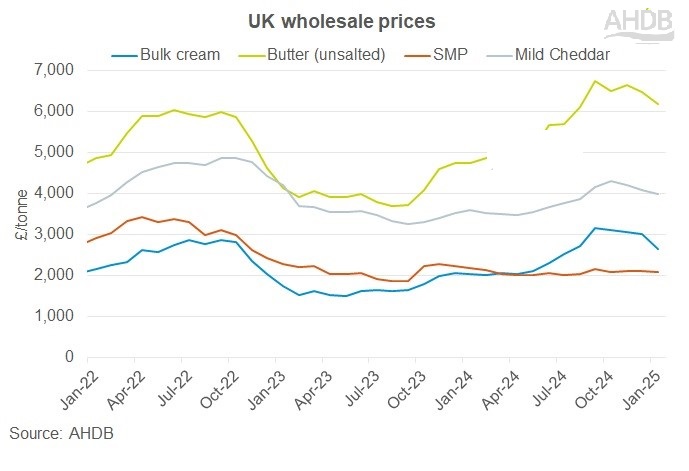
.jpg)
Prices
Domestic consumer demand is expected to be stable in 2025, with consumer confidence recovering to some extent. The increase to employer National Insurance contributions, as well as a significant increase to the National Living Wage could fuel inflation. Forecasts by KPMG are for inflation to hover in the 2−3% range for 2025, above the Bank of England’s 2% target. This could suppress demand growth to some extent.
Growing milk supplies should begin to put milk prices down as we head into the flush. However, limited supplies of some commodities, particularly butter, and growing demand for cheese should offer some support for prices. There are signs of growing import demand from China due to reduced domestic production and some return of demand growth for dairy products such as butter in bakery and cheese. This should offer some support for global prices.
In China, stocks are rebalancing as production growth slows. Low farmgate prices, as well as a heat wave in Q3, caused further exits from the industry, dampening down China’s domestic milk supplies. Rabobank estimates a 0.5% year-on-year reduction in production over the second half of 2024, with a steeper 1.5% drop in 2025. However, better balanced production and some demand recovery in 2025 is expected to contribute toward a 2% increase in import volumes.
Impact on farmgate prices
GB farmgate prices remained stable through the first half of 2024 at around 38ppl but then began to climb significantly through the second half of the year, ending at around 45ppl (excluding bonus and aligned contracts). Prices remain significantly below the peak of 2022 levels, but input costs have also fallen.
The annual average milk price in GB is expected to be in the region of 42ppl for the 2024/25 season, taking into account announced price increases to Jan-24. This compares to an average of 38ppl in the previous season.
Increases in milk prices seen were as a result of weakened milk production off the back of an incredibly wet period from autumn 2023 to spring 2024. Teamed with weak supplies globally, commodity values for fats in particular reached record-breaking levels which have fuelled price increases.
Input costs broadly steadied in 2024 but remained well above pre-Covid levels. Softening of input prices has given welcome relief to margin pressures – but only partially, with many reports of some businesses struggling with cash flows. Higher interest rates also caused a rise in borrowing costs. Unfortunately, this has led to some farmers leaving the sector, with the number of dairy farms in GB declining by 4.0% since 2023. Concerns over inheritance tax requirements following the latest Budget will only serve to fuel this trend further, with some seeking to liquidate their assets.
While the cost of some inputs did steady, they remained historically high. We explore prospects for farm inputs in our dedicated outlooks. These are due to be updated in late February 2025:

The growth in the value of dairy products has now halted, and prices have been decreasing marginally during the latter part of 2024 and into January 2025. The record-breaking fats prices seen have filtered through to consumers who are modifying their demand for products like butter as a result and trading down to cheaper alternatives. However, demand for cheese and yogurt remains strong which will give a boost to wider dairy demand.
Growing milk production could push prices down as we head towards the flush. However, much will depend on the spring flush itself and how demand develops. Production increases continuing through the flush period could pressurise the market which would stall the recovery in prices, depending on demand. China is expected to return to the market this year, but not in a large way. Rabobank expects Chinese imports to return to growth after three years of decline; the extent of this demand will play a major role in supporting global prices. However, supply and demand will need to find an equilibrium this year.
Consumption
In 2024, total dairy retail volume was down 0.6% year-on-year (Source: AHDB/Nielsen 52 w/e 28 December 2024). For 2025, we expect this will remain the same. However, there are some nuances in the different categories. As dairy is dominated by milk, the milk trend impacts the total category.
For more data and latest trends for all dairy categories, visit our Dairy retail dashboard.
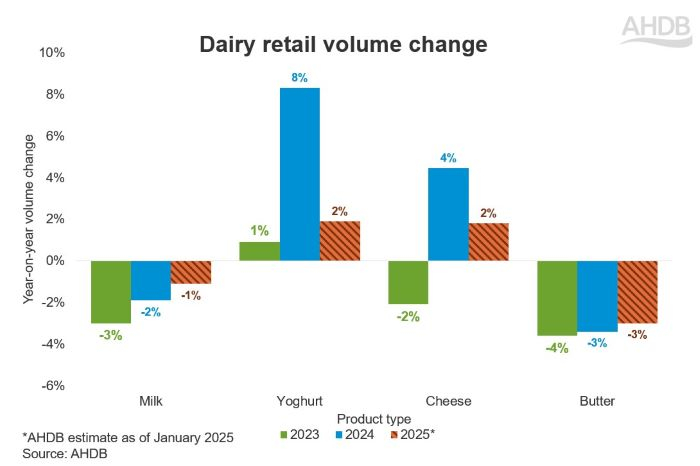

For 2025 we expect a level of economic uncertainty as detailed in our economic outlook. We expect business confidence will remain low, and this will likely feed down to shoppers. After multiple years of overcoming challenges and reconsidering how to spend their money, we expect any changes in shopping behaviour to be gradual.
Milk
Retail prices are likely to remain relatively stable in 2025. Over 9 in 10 households are buying cow’s milk (NIQ Panel on Demand, Total GB, 52 w/e 29 December 2024) and we don’t expect penetration to change. However, we predict the volume per household may drop for milk as people are encouraged to return to the office. This means less opportunities for hot drinks, which make up 65% of liquid milk occasions in-home (Kantar usage, 52 w/e 12 May 2024). Some of this will likely move into the out-of-home market, which is not covered in this outlook.
The trend towards buying whole milk will likely continue into 2025. But with declines still expected for semi-skimmed and skimmed milk, we predict retail milk volume to be down by 1% year-on-year.
Cheese
Consumers are looking for tasty, cheaper ingredients when cooking dishes, and we expect this will continue to benefit cheese demand. Cheese has been strongly supported by promotions over the last year, and we think this may be scaled back by retailers and brands in 2025. As a result, we expect consumers will scale back the number of different cheese products they buy. This will benefit more traditional varieties such as Cheddar.
Cheddar may also be boosted by an increase in lunchbox occasions as workers return to the office more days per week. We predict retail cheese volumes will increase by 1.8% year-on-year.
Butter
The price differentiation between butter and plant spreads will remain a key driver of demand through 2025.
Despite its higher price point, we expect block butter will perform better than dairy spreads as it meets consumer needs for natural, whole foods and is used for specific occasions such as baking. However, losses in dairy spreads will wipe out any uplifts from block butter.
The watch area for the butter category is the price of plant oils vs butter fats. If global forces impact the prices of plant oils (and therefore the cost of plant-based spreads), and the price of butter comes down, we could see some switching back to cow’s butter. However, currently we predict volume sales of butter in retail to decline by 3% on 2024.
Yogurt
In the first quarter of 2025, we anticipate yogurt will continue to do well. But for the remainder of the year, as we annualise on a strong performance and the economy may be more uncertain, we expect the growth will start to slow.
For some shoppers price will come back as the major driver instead of health this year, but, for many, health will still be a priority. Therefore, we expect yogurts with health claims such as pre-biotics, pro-biotics and protein to perform well. Yogurt may also be boosted by its growing inclusion in recipes on social media. We expect growth will not be as strong as last year but remain up 2% year-on-year.
How might the outlook for dairy demand be improved?
The dairy outlook might be improved if the industry will:
- Encourage consumption of dairy through reminding consumers of key consumption moments and needs. Milk through hot drinks and cereal, and cheese through tasty and filling meals
- Highlight dairy as a cost-effective and natural source of protein, calcium and vitamin B12. Communicating the benefits of these vitamins and minerals addresses consumers’ need for value while supporting the long-term health perception of dairy
- Action new research (which AHDB will publish in 2025) on effective messaging for milk in-store and on pack to encourage consumer demand
- In the longer term, look to maintain and build consumer trust, demonstrating where farming values (animal welfare, environmental stewardship and expertise) are shared with consumers
AHDB has a range of marketing activities planned for the year, including the new Let’s Eat Balanced campaign. Please visit our marketing pages for more information.
For more insight around consumer demand, visit our retail and consumer pages.
While AHDB seeks to ensure that the information contained on this webpage is accurate at the time of publication, no warranty is given in respect of the information and data provided. You are responsible for how you use the information. To the maximum extent permitted by law, AHDB accepts no liability for loss, damage or injury howsoever caused or suffered (including that caused by negligence) directly or indirectly in relation to the information or data provided in this publication.
All intellectual property rights in the information and data on this webpage belong to or are licensed by AHDB. You are authorised to use such information for your internal business purposes only and you must not provide this information to any other third parties, including further publication of the information, or for commercial gain in any way whatsoever without the prior written permission of AHDB for each third party disclosure, publication or commercial arrangement. For more information, please see our Terms of Use and Privacy Notice or contact the Director of Corporate Affairs at info@ahdb.org.uk © Agriculture and Horticulture Development Board. All rights reserved.

